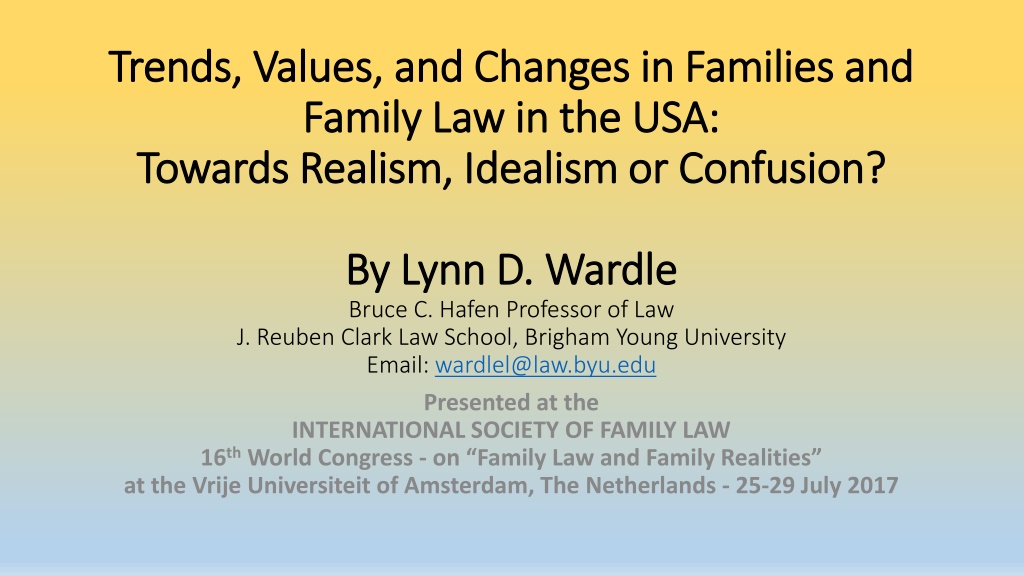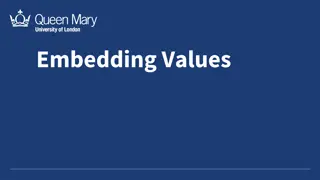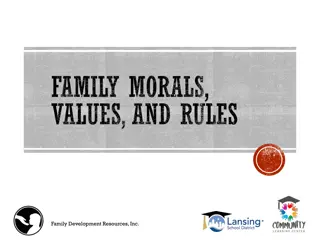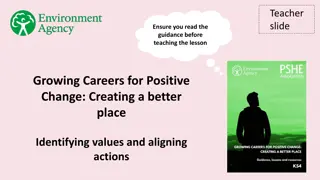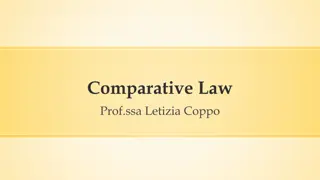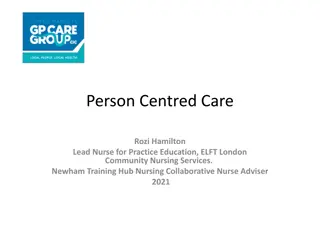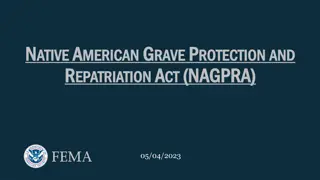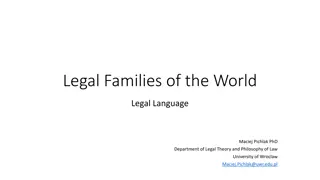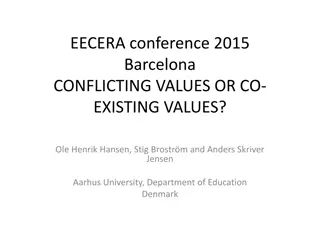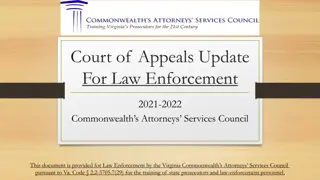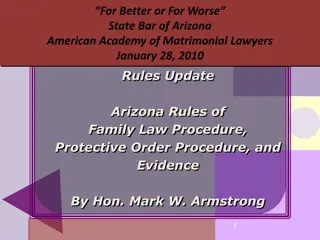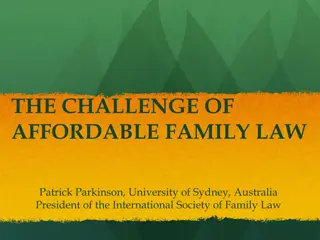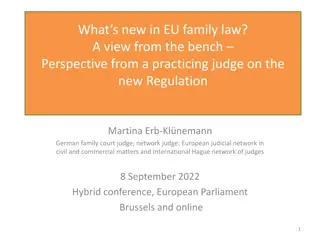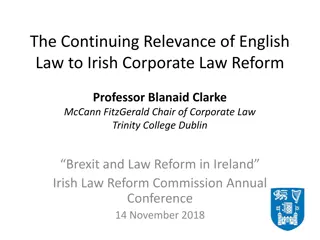Trends, Values, and Changes in American Family Law
This paper analyzes recent developments in American family law focusing on the balance between realism and idealism. It explores the diversity and variations in family laws across different states, highlighting the gap between social reality and legal standards.
Download Presentation

Please find below an Image/Link to download the presentation.
The content on the website is provided AS IS for your information and personal use only. It may not be sold, licensed, or shared on other websites without obtaining consent from the author.If you encounter any issues during the download, it is possible that the publisher has removed the file from their server.
You are allowed to download the files provided on this website for personal or commercial use, subject to the condition that they are used lawfully. All files are the property of their respective owners.
The content on the website is provided AS IS for your information and personal use only. It may not be sold, licensed, or shared on other websites without obtaining consent from the author.
E N D
Presentation Transcript
Trends, Values, and Changes in Families and Trends, Values, and Changes in Families and Family Law in the Family Law in the USA: Towards Towards Realism, Idealism or Confusion? Realism, Idealism or Confusion? USA: By Lynn D. Wardle By Lynn D. Wardle Bruce C. Hafen Professor of Law J. Reuben Clark Law School, Brigham Young University Email: wardlel@law.byu.edu Presented at the INTERNATIONAL SOCIETY OF FAMILY LAW 16thWorld Congress - on Family Law and Family Realities at the Vrije Universiteit of Amsterdam, The Netherlands - 25-29 July 2017
I. Introduction: Balancing Idealism and Realism in American Family Law This paper analyzes recent developments in American family law from the perspective of the tension in law between recognizing the real and seeking the ideal. It discusses some recent developments in American family law regulating parent-child relationships as well as spousal relationships.
This paper includes some discussion of current marriage law in the United States of America. American marriage laws vary from state to state, sometimes significantly. Different communities strike different balances between the realistic and the idealistic in their marriage laws. To unfamiliar observers, the differences may appear to indicate confusion. To the well-informed, however, the differences in American family laws represent inclusion of diversities and freedom.
II. The Gap Between the Real and the Ideal in American Family Law One of the great and persistent jurisprudential questions is whether the law primarily reflects social reality and values, or imposes and promotes certain ideals and standards. Anthropologist Stanley Diamond argued that instead of law and order in society, the more common reality is law versus order. He wrote that: We live in a law-ridden society; law has cannibalized the institutions which it presumably reinforces or with which it interacts .
III. Some Diversity in Family Law Reflects Differences Between Communities In the United States of America, there is not one body of family law, but at least fifty-one (arguably fifty-seven) different family law systems, each with its own diverse, substantive family laws. Most American family law is state law, not federal law, and it often varies (sometimes quite dramatically) from state to state.
The Supreme Court of the United States decides a very small number of cases involving family law. The Supreme Court now hears approximately seventy (70) cases each term, out of nearly 7,000 petitions for review that it receives each term. In the most recent term of the Supreme Court (the October 2016 Term, which concluded in late June 2017), the Supreme Court decided only three cases that dealt with some aspect of family law.
IV. Ideology vs. Reality Only one Supreme Court case decided in the 2016 term concerned a traditional state family law (the other two cases involved federal laws). In Pavan v. Smith, the Supreme Court per curiam (6-3) struck down an Arkansas birth certificate law requiring the name of the mother s male spouse to appear on the child s birth certificate regardless of his biological relationship to the child but not allowing a female same-sex spouse of the mother to be named on the birth certificate.
In one sense, the Courts recent Pavan ruling seems unnecessary under its ruling just two years ago in Obergefell v. Hodges invalidating state laws barring same sex couples from marrying. In another sense, however, Pavan was a significant and controversial expansion of the same-sex marriage ruling in Obergefell. It would have been easy for the Court to distinguish the vertical relationship of parent/partner- child in Pavan from the horizontal, adult co-equal relationship of marriage involved in Obergefell. Critics might suggest that childrens welfare was subordinated by the Pavan majority to the interests and preferences of same-sex adult partners.
Among parents who live with a child under the age of 18, [eighty-nine percent] 89% of college graduates are married, compared with 64% of parents with less than a high school diploma and 70% of those with just a high school diploma. When it comes to matrimony, the United States is two separate countries. There s college-graduate America, where getting married and staying married is still the norm. Then there s the rest of America, where marriage rates are retreating and divorce is rampant. As Robert Pollack has explained: College graduates men and women are using marriage as a commitment device to jointly invest in a lot of children .
Marriage has been on the decline for decades, particularly for those with less education. At the same time, the share of non-marital births for the less educated has risen dramatically, and the likelihood of divorce remains significantly higher among those lacking a college degree than among those who have one.
Approximately 30% of moms with less than a college degree who live with their kids are living without a spouse or partner, as compared with 7% of comparable dads. In comparison, [just] 13% of college-educated moms who live with their kids are living without a spouse or partner, as are 3% of comparable dads.
Since 1950, marriage behavior in the United States has changed dramatically, though most men and women still marry at some point in their lives, they now do so later and are more likely to divorce.
Weve seen a retreat from marriage within all racial and ethnic groups and across the socioeconomic spectrum. But the decoupling of marriage and parenthood has been much less prevalent among college graduates.
Sara McLanahan has concluded: Children of single-parent families suffer measurable harm. Children who grow up with only one of their biological parents (nearly always the mother) are disadvantaged across a broad array of outcomes. [T]hey are twice as likely to drop out of high school, 2.5 times as likely to become teen mothers, and 1.4 times as likely to be idle -- out of school and out of work -- as children who grow up with both parents. Children in one-parent families also have lower grade point averages, lower college aspirations, and poorer attendance records. As adults, they have higher rates of divorce.
Researchers at the National Center for Health Statistics estimate that 78% of college-educated women who married for the first time between 2006 and 2010 could expect their marriages to last at least 20 years. But among women who have a high school education or less, the share is only 40%.
Sharp differences on longevity of marriages by race, ethnicity
People from cultures that value marriage more tend to have longer, healthier, and happier marriages and richer, more fulfilling lives than do people from cultures that value marriage less.
V. How to Revive a Marriage Culture The law must protect and facilitate fulfillment of the marriage aspiration the desire of a man and a woman to unite in fidelity in a loving, intentional, life-long union to care for and support each other and their children. Yet how to do that seems to be a mystery.
Today . . . marriage in America seems to be dying. In 2010, according to the Pew Research Center, only about half of all Americans over age eighteen were married, compared to nearly three out of four in 1960. Americans today are marrying later, if at all, and the share of Americans who [have] never married has climbed to record highs. As one result, the share of children growing up with single moms is also skyrocketing; in 2013, 41 percent of all births were to unmarried women.
[T]he share of young college-graduate white women who were married in 2010 was a little over 70 percent almost exactly the same as it was in 1950. Fewer than 9 percent of women with a bachelor s degree or more had an unwed birth in 2011 a level barely higher than what it was for all women in 1950.
Marital Status Among Young Adults Ages 25-34 (Percent) Source: U.S. Census Bureau, 2000 Census and American Community Survey. Year: 2000 2006 2007 2008 2009 Married 55.1 48.9 48.2 46.9 44.9 Never Married 34.5 41.4 42.6 43.9 46.3 http://www.prb.org/Publications/Articles/2010/usmarriagedecline.aspx
Marriage Rates Among Young Adults Ages 25-34, 1965-2010 (Percent) Source: U.S. Census Bureau, 2000 Census and American Community Survey. http://www.prb.org/Publications/Articles/2010/usmarriagedecline.aspx
Source: Haskins (2015) Married Parents: One Way of Reducing Child Poverty W. Bradford Wilcox, Director, National Marriage Project and Professor of Sociology, University of Virginia; Senior Fellow, Institute for Family Studies; Visiting Scholar, American Enterprise Institute
Sharp differences on longevity of marriages by race, ethnicity Wendy Wang, The link between a college education and a lasting marriage, Pew Research Center, FactTack, 4 Dec. 2015, at http://www.pewresearch.org/f act- tank/2015/12/04/education- and-marriage/ (seen 11 July 2017).
Jordan Weissman, Marriage Stages a Comeback (but Mostly Just for College Grads), The Atlantic, 7 Feb. 2014, at https://www.theatlantic. com/business/archive/20 14/02/marriage-stages-a- comeback-but-mostly- just-for-college- grads/283682/ (seen 13 July 2017).
[K]ids raised in married-parent households are much less likely to grow up in poverty, more likely to do better in school, and more likely to move up the economic ladder even if they start out poor. There s no argument about what s best for kids, says the economic and social policy expert Ron Haskins, of the Brookings Institution. It s to be reared in a stable household by married parents.
VI. Conclusion: We Must Rebuild a Culture of Marriage in All of Our Nations Marriage is the key. Marriage makes all the difference!
Baroness Ruth Deech summarized the importance of marriage well when she said that marriage [n]ot only is the safest environment for children, it provides a link to history, to previous generations and generations yet to come. Baroness Deech also spoke a profound truth when she declared: It is marriage that makes all the difference.
We must work to rebuild and revitalize the culture of marriage in our communities, nations, and societies. That is a task fitting for family law professors to undertake. If we can make any progress toward reviving marriage that ultimately will benefit not only our own posterity, but it will benefit all humanity.
